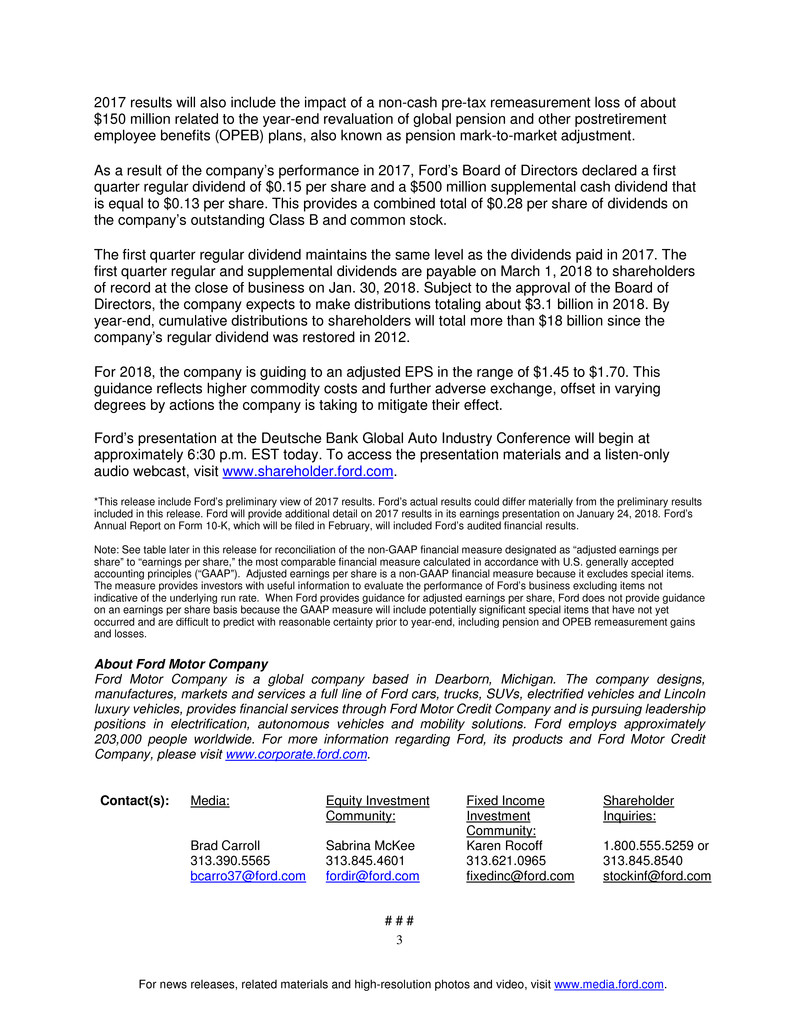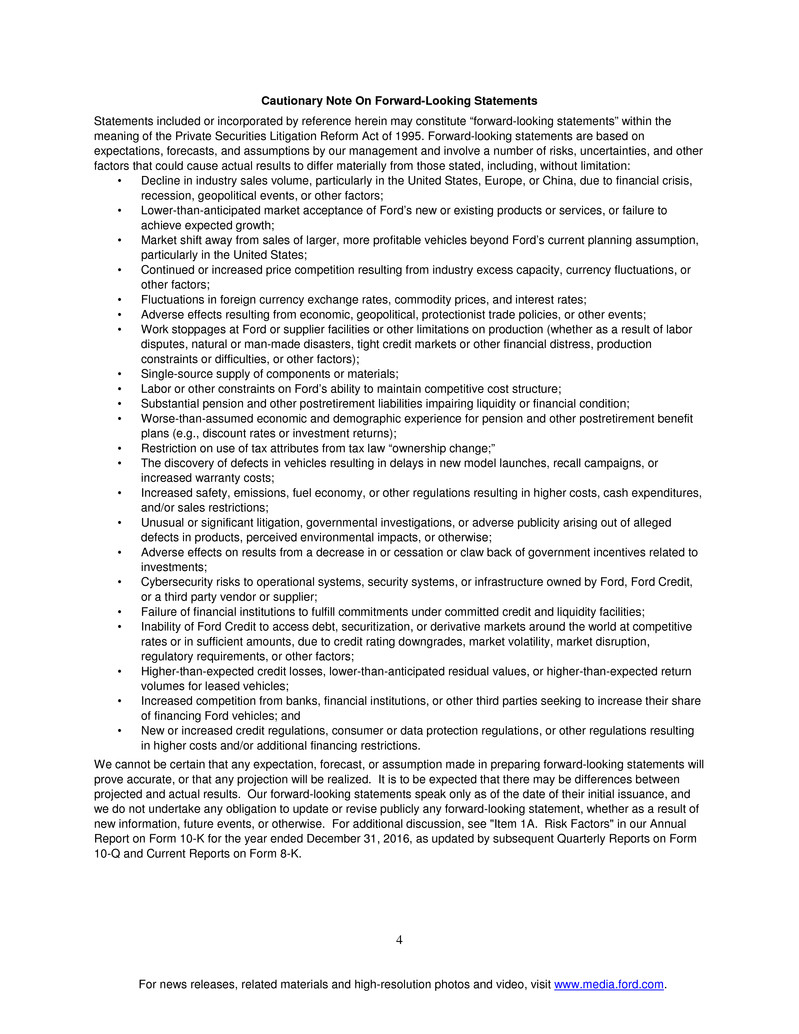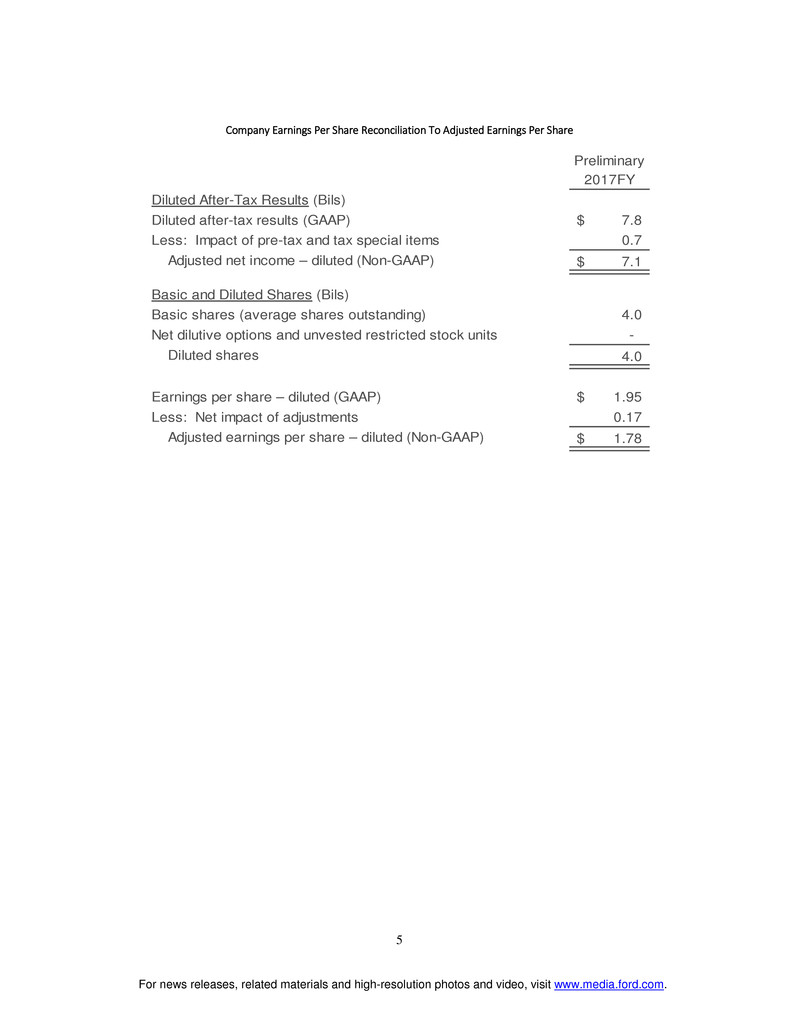Attached files
| file | filename |
|---|---|
| EX-99.2 - EXHIBIT 99.2 - FORD MOTOR CO | exhibit992todeutschebank.htm |
| 8-K - 8-K - FORD MOTOR CO | deutschebankconference8-kd.htm |

NEWS
For news releases, related materials and high-resolution photos and video, visit www.media.ford.com.
www.twitter.com/ford
www.facebook.com/ford
Ford Details Plans to Improve Fitness, Refocus Model Lineup
and Accelerate Introduction of Smart Vehicles and Services
• Operational fitness, portfolio rationalization and increased investments in electrification,
autonomy and mobility at core of company strategy
• Company increases planned investments in electrification to $11 billion by 2022
• Expanded electrified portfolio to include 40 electrified vehicles globally, including 16 full
battery electric vehicles by 2022
• Announces preliminary results for full-year 2017 of $1.95 earnings-per-share (EPS) and
$1.78 adjusted EPS, in line with most recent guidance range
• Declares first quarter regular dividend of $0.15 per share and a $500 million
supplemental cash dividend – or $0.13 per share – for a combined $0.28 per share
• Company issues guidance for 2018 of adjusted EPS of $1.45 to $1.70
DEARBORN, Mich., Jan. 16, 2018 – Ford Motor Company (NYSE: F) today detailed plans to
improve operational fitness, refocus capital allocation and accelerate the introduction of smart
vehicles and services.
Presenting at the Deutsche Bank Global Auto Industry Conference in Detroit, the company
provided preliminary results for full-year 2017, issued guidance for 2018 and outlined plans to
accelerate investment in electric vehicles and sport utility vehicles.
“In 2017, F-Series extended its streak as America's best-selling pickup for the 41st straight year,
we set a new company high for U.S. SUV sales and Lincoln had its best year since the turn of
the millennium thanks to accelerated growth in China,” said Jim Farley, Ford executive vice
president and president, Global Markets. “We have a rock solid foundation and we have seen
growth in key areas, but we know we must evolve to be even more competitive, and narrow our
full line of nameplates in all markets, to a more focused lineup that delivers stronger, more
profitable growth, with better returns.”
Bob Shanks, executive vice president and chief financial officer, said Ford is working rapidly to
improve its operational fitness and reallocate capital to higher-return opportunities that is
expected to fuel profitable growth in the future.
“Since we reinstated a dividend in 2012, we have generated $31 billion in cumulative
automotive cash flow, and returned $15.4 billion to shareholders via dividends and share
repurchase,” said Bob Shanks, executive vice president and chief financial officer.
“Notwithstanding this discipline of returning value to shareholders, we know we can better
capture opportunities for growth, profitability and liquidity.”
The full slide deck of Ford’s presentation can be found at www.shareholder.ford.com.

For news releases, related materials and high-resolution photos and video, visit www.media.ford.com.
2
Ford is further detailing its fitness initiatives first outlined at a presentation to analysts last fall.
This includes making changes to products in production today and dramatically improving the
efficiency of the business.
For example, the company is reducing the number of orderable combinations on Escape,
Fusion and EcoSport from thousands, to just 10 to 20 combinations for each vehicle. This will
improve costs by reducing manufacturing expense, lowering inventory and logistics expense
and improve quality, while growing revenue by ensuring customers can get what they want
faster and at the dealer of their choosing.
The company said it would continue to pursue partnerships, alliances, and acquisitions as a key
component to enhance its competitiveness. Ford is pursuing partnerships, alliances, and
acquisitions where doing so provides access to technology and capabilities that will enhance its
competitive position, including with Mahindra in India and Zotye in China to develop vehicles
and services uniquely suited to compete in those markets.
In addition, Ford said it will shift toward a lower volume passenger car lineup in North America
and Europe, while competing in more profitable sub-segments of the utilities market, as
demonstrated by vehicles such as the new Edge ST and the upcoming Bronco. In North
America, for example, over the next couple of years, Ford’s SUV mix will increase 10
percentage points, while its car portfolio will shrink about 10 percentage points.
Ford also will expand its electrified vehicle lineup with a total of 40 vehicles globally, which will
include 16 full battery electric vehicles by 2022. To support this, the company announced that it
now plans to invest more than $11 billion in electrification from 2015 to 2022. The company also
reiterated that it is on track to deliver a full battery electric performance SUV that offers at least
a 300-mile range, for launch in 2020.
“We are actively evolving our position to be more competitive,” Farley said. “At the highest level,
we need to narrow our full lineup of nameplates to a more focused lineup that delivers stronger
growth, less risk and better returns. We are repositioning the company to offer best-in-class,
human-centered vehicles and mobility services. That’s our vision.”
Regarding self-driving vehicles, Ford is focused on building an autonomous vehicle business,
including a purpose-built vehicle, the self-driving technology and the operational infrastructure in
parallel, which will allow it to scale quickly as it enters production in 2021. Collaborations with
Dominos, Lyft and Postmates will help validate its self-driving services business beginning this
quarter though a series of pilot programs in a new city to be identified soon.
2017 Preliminary Results and 2018 Guidance*
For full-year 2017, the company is announcing preliminary results of $1.95 EPS, an increase of
80 cents from a year ago, and adjusted EPS of $1.78, an increase of 2 cents from a year ago
and in line with the company’s most recent guidance. The company also anticipates ending the
year with a strong balance sheet with automotive cash of $26.5 billion and automotive liquidity
of nearly $37 billion.

For news releases, related materials and high-resolution photos and video, visit www.media.ford.com.
3
2017 results will also include the impact of a non-cash pre-tax remeasurement loss of about
$150 million related to the year-end revaluation of global pension and other postretirement
employee benefits (OPEB) plans, also known as pension mark-to-market adjustment.
As a result of the company’s performance in 2017, Ford’s Board of Directors declared a first
quarter regular dividend of $0.15 per share and a $500 million supplemental cash dividend that
is equal to $0.13 per share. This provides a combined total of $0.28 per share of dividends on
the company’s outstanding Class B and common stock.
The first quarter regular dividend maintains the same level as the dividends paid in 2017. The
first quarter regular and supplemental dividends are payable on March 1, 2018 to shareholders
of record at the close of business on Jan. 30, 2018. Subject to the approval of the Board of
Directors, the company expects to make distributions totaling about $3.1 billion in 2018. By
year-end, cumulative distributions to shareholders will total more than $18 billion since the
company’s regular dividend was restored in 2012.
For 2018, the company is guiding to an adjusted EPS in the range of $1.45 to $1.70. This
guidance reflects higher commodity costs and further adverse exchange, offset in varying
degrees by actions the company is taking to mitigate their effect.
Ford’s presentation at the Deutsche Bank Global Auto Industry Conference will begin at
approximately 6:30 p.m. EST today. To access the presentation materials and a listen-only
audio webcast, visit www.shareholder.ford.com.
*This release include Ford’s preliminary view of 2017 results. Ford’s actual results could differ materially from the preliminary results
included in this release. Ford will provide additional detail on 2017 results in its earnings presentation on January 24, 2018. Ford’s
Annual Report on Form 10-K, which will be filed in February, will included Ford’s audited financial results.
Note: See table later in this release for reconciliation of the non-GAAP financial measure designated as “adjusted earnings per
share” to “earnings per share,” the most comparable financial measure calculated in accordance with U.S. generally accepted
accounting principles (“GAAP”). Adjusted earnings per share is a non-GAAP financial measure because it excludes special items.
The measure provides investors with useful information to evaluate the performance of Ford’s business excluding items not
indicative of the underlying run rate. When Ford provides guidance for adjusted earnings per share, Ford does not provide guidance
on an earnings per share basis because the GAAP measure will include potentially significant special items that have not yet
occurred and are difficult to predict with reasonable certainty prior to year-end, including pension and OPEB remeasurement gains
and losses.
About Ford Motor Company
Ford Motor Company is a global company based in Dearborn, Michigan. The company designs,
manufactures, markets and services a full line of Ford cars, trucks, SUVs, electrified vehicles and Lincoln
luxury vehicles, provides financial services through Ford Motor Credit Company and is pursuing leadership
positions in electrification, autonomous vehicles and mobility solutions. Ford employs approximately
203,000 people worldwide. For more information regarding Ford, its products and Ford Motor Credit
Company, please visit www.corporate.ford.com.
Contact(s): Media: Equity Investment Fixed Income Shareholder
Brad Carroll
Community:
Sabrina McKee
Investment
Community:
Karen Rocoff
Inquiries:
1.800.555.5259 or
313.390.5565 313.845.4601 313.621.0965 313.845.8540
bcarro37@ford.com
fordir@ford.com fixedinc@ford.com stockinf@ford.com
# # #

For news releases, related materials and high-resolution photos and video, visit www.media.ford.com.
4
Cautionary Note On Forward-Looking Statements
Statements included or incorporated by reference herein may constitute “forward-looking statements” within the
meaning of the Private Securities Litigation Reform Act of 1995. Forward-looking statements are based on
expectations, forecasts, and assumptions by our management and involve a number of risks, uncertainties, and other
factors that could cause actual results to differ materially from those stated, including, without limitation:
• Decline in industry sales volume, particularly in the United States, Europe, or China, due to financial crisis,
recession, geopolitical events, or other factors;
• Lower-than-anticipated market acceptance of Ford’s new or existing products or services, or failure to
achieve expected growth;
• Market shift away from sales of larger, more profitable vehicles beyond Ford’s current planning assumption,
particularly in the United States;
• Continued or increased price competition resulting from industry excess capacity, currency fluctuations, or
other factors;
• Fluctuations in foreign currency exchange rates, commodity prices, and interest rates;
• Adverse effects resulting from economic, geopolitical, protectionist trade policies, or other events;
• Work stoppages at Ford or supplier facilities or other limitations on production (whether as a result of labor
disputes, natural or man-made disasters, tight credit markets or other financial distress, production
constraints or difficulties, or other factors);
• Single-source supply of components or materials;
• Labor or other constraints on Ford’s ability to maintain competitive cost structure;
• Substantial pension and other postretirement liabilities impairing liquidity or financial condition;
• Worse-than-assumed economic and demographic experience for pension and other postretirement benefit
plans (e.g., discount rates or investment returns);
• Restriction on use of tax attributes from tax law “ownership change;”
• The discovery of defects in vehicles resulting in delays in new model launches, recall campaigns, or
increased warranty costs;
• Increased safety, emissions, fuel economy, or other regulations resulting in higher costs, cash expenditures,
and/or sales restrictions;
• Unusual or significant litigation, governmental investigations, or adverse publicity arising out of alleged
defects in products, perceived environmental impacts, or otherwise;
• Adverse effects on results from a decrease in or cessation or claw back of government incentives related to
investments;
• Cybersecurity risks to operational systems, security systems, or infrastructure owned by Ford, Ford Credit,
or a third party vendor or supplier;
• Failure of financial institutions to fulfill commitments under committed credit and liquidity facilities;
• Inability of Ford Credit to access debt, securitization, or derivative markets around the world at competitive
rates or in sufficient amounts, due to credit rating downgrades, market volatility, market disruption,
regulatory requirements, or other factors;
• Higher-than-expected credit losses, lower-than-anticipated residual values, or higher-than-expected return
volumes for leased vehicles;
• Increased competition from banks, financial institutions, or other third parties seeking to increase their share
of financing Ford vehicles; and
• New or increased credit regulations, consumer or data protection regulations, or other regulations resulting
in higher costs and/or additional financing restrictions.
We cannot be certain that any expectation, forecast, or assumption made in preparing forward-looking statements will
prove accurate, or that any projection will be realized. It is to be expected that there may be differences between
projected and actual results. Our forward-looking statements speak only as of the date of their initial issuance, and
we do not undertake any obligation to update or revise publicly any forward-looking statement, whether as a result of
new information, future events, or otherwise. For additional discussion, see "Item 1A. Risk Factors" in our Annual
Report on Form 10-K for the year ended December 31, 2016, as updated by subsequent Quarterly Reports on Form
10-Q and Current Reports on Form 8-K.

For news releases, related materials and high-resolution photos and video, visit www.media.ford.com.
5
Company Earnings Per Share Reconciliation To Adjusted Earnings Per Share
Preliminary
2017FY
Diluted After-Tax Results (Bils)
Diluted after-tax results (GAAP) 7.8$
Less: Impact of pre-tax and tax special items 0.7
Adjusted net income – diluted (Non-GAAP) 7.1$
Basic and Diluted Shares (Bils)
Basic shares (average shares outstanding) 4.0
Net dilutive options and unvested restricted stock units -
Diluted shares 4.0
Earnings per share – diluted (GAAP) 1.95$
Less: Net impact of adjustments 0.17
Adjusted earnings per share – diluted (Non-GAAP) 1.78$
